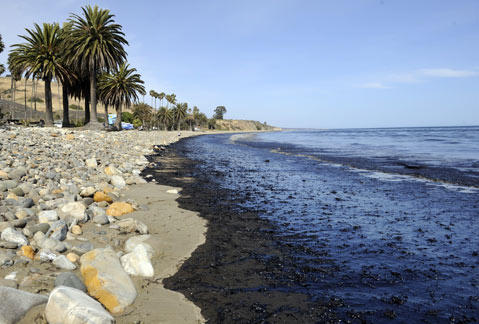Refugio Oil Disaster Reminds There Will Be Spills
Santa Barbara County Grapples with Worst Oil Mess in Nearly 50 Years

Pipes break. Equipment malfunctions. Human beings screw up. So long as oil is pumped from underground oil reservoirs — a technology both ingenious and violent — there will be spills. One would think Santa Barbara, home to the most defining oil spill in American history, would need little reminding. But sometime last Tuesday morning, fugitive oil began bubbling out of a broken pipeline owned by the Plains All American Pipeline company along the Gaviota Coast. Once again, county residents got the proverbial wake-up call that such spills are not a matter of if but when. The rough estimates remain as they were a week ago. More than 100,000 gallons escaped from a ruptured pipeline on the mountain side of the freeway. Of those, 21,000 gallons (or 500 barrels) somehow managed to make their way under Highway 101 and into the ocean.
Compared to the Deepwater Horizon explosion that spewed nearly 5 million barrels into the Gulf of Mexico — or even the 100,000 barrels let loose during Santa Barbara’s 1969 nightmare — our recent spill barely qualifies as a gob of spit. Still, this is the birthplace of the environmental movement. And the Gaviota Coast — one of most biologically rich and enchanting spots anywhere on planet Earth — is definitely not the place any sane-minded oil operator wants to accidentally lose 500 barrels of thick viscous crude.
It’s perversely fitting that earlier Tuesday morning, two Plains All American Pipeline employees were participating in an oil-spill emergency drill taking place just two miles off the coast at a facility owned by the oil company Freeport-McMoRan. That spill drill would be cut short as county fire fighters found themselves inundated with complaints about invasive acrid odors, like creosote on steroids.
At this writing, cleanup efforts continue, but the sense of crisis has waned. Now we can assess how well emergency responders functioned in our own collective spill drill. As to be expected, the preliminary reviews are mixed; clear, accurate, reliable information proved extremely elusive. But one revelation did emerge: Along the 10-mile stretch of coastal pipeline owned and operated by Plains All American, there’s no automatic shutoff capacity for emergencies such as this. According to the director of Santa Barbara County’s Energy Division — shocked to learn of this deficiency — such equipment is required for all other oil pipelines in the county.
From the start, critical voices questioned the speed of the emergency response. How was it that bucket brigades of citizen volunteers wearing flip-flops and rain boots could hit the oil-soaked beaches before squads of paid professionals donned in white hazmat gear and protective yellow booties? How fast did the boats arrive with skimmers and booms in tow? And how effectively did the Coast Guard and Environmental Protection Agency — the federal agencies running the show — interface with the area officials who had both the resources and know-how to contribute?
The following articles provide The Santa Barbara Independent’s first-blush look at such questions. More reporting will follow as the facts become known. Such information matters. Pipes break, equipment malfunctions, and people screw up. And as long as there’s oil to be drilled, there will be spills.



